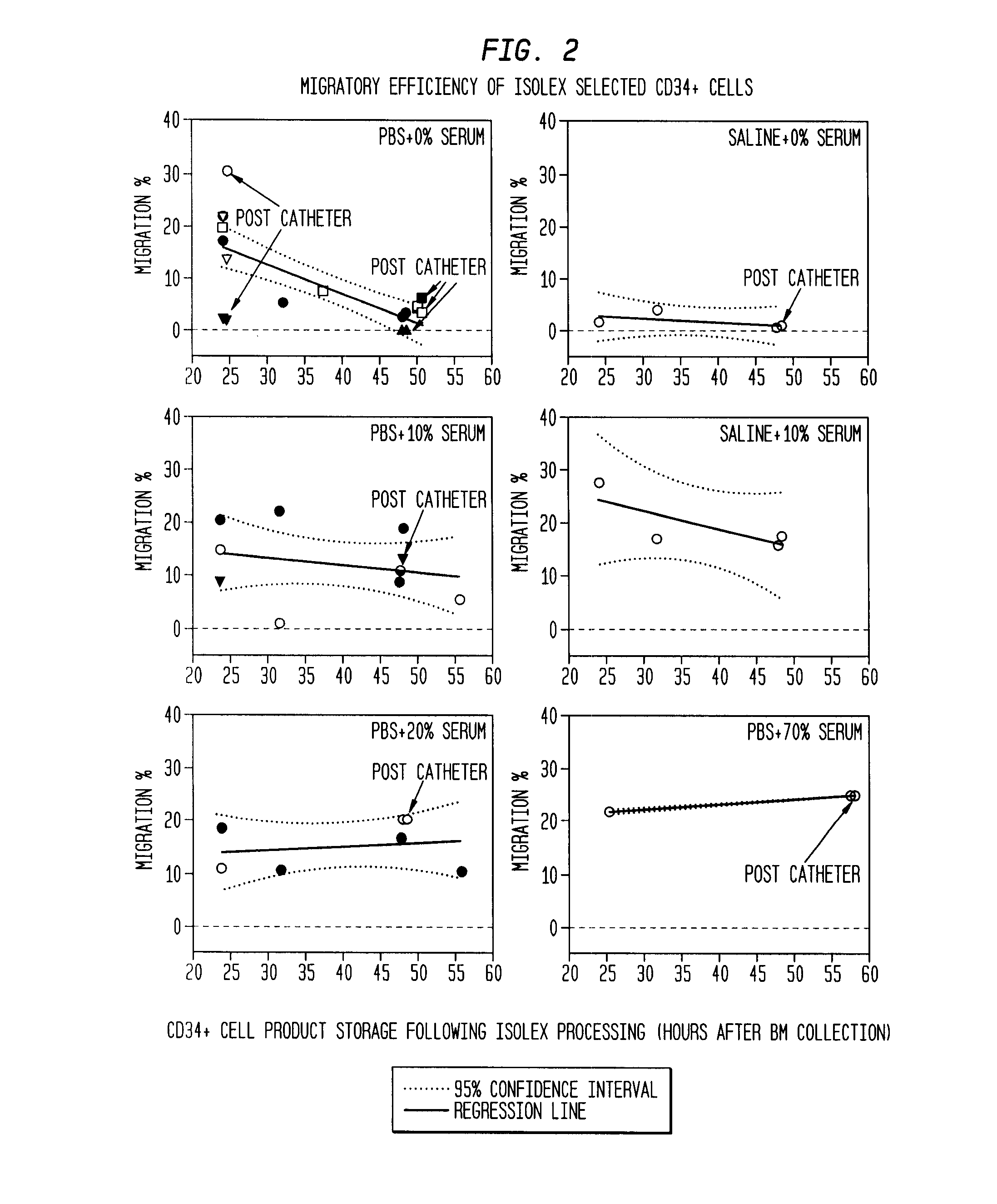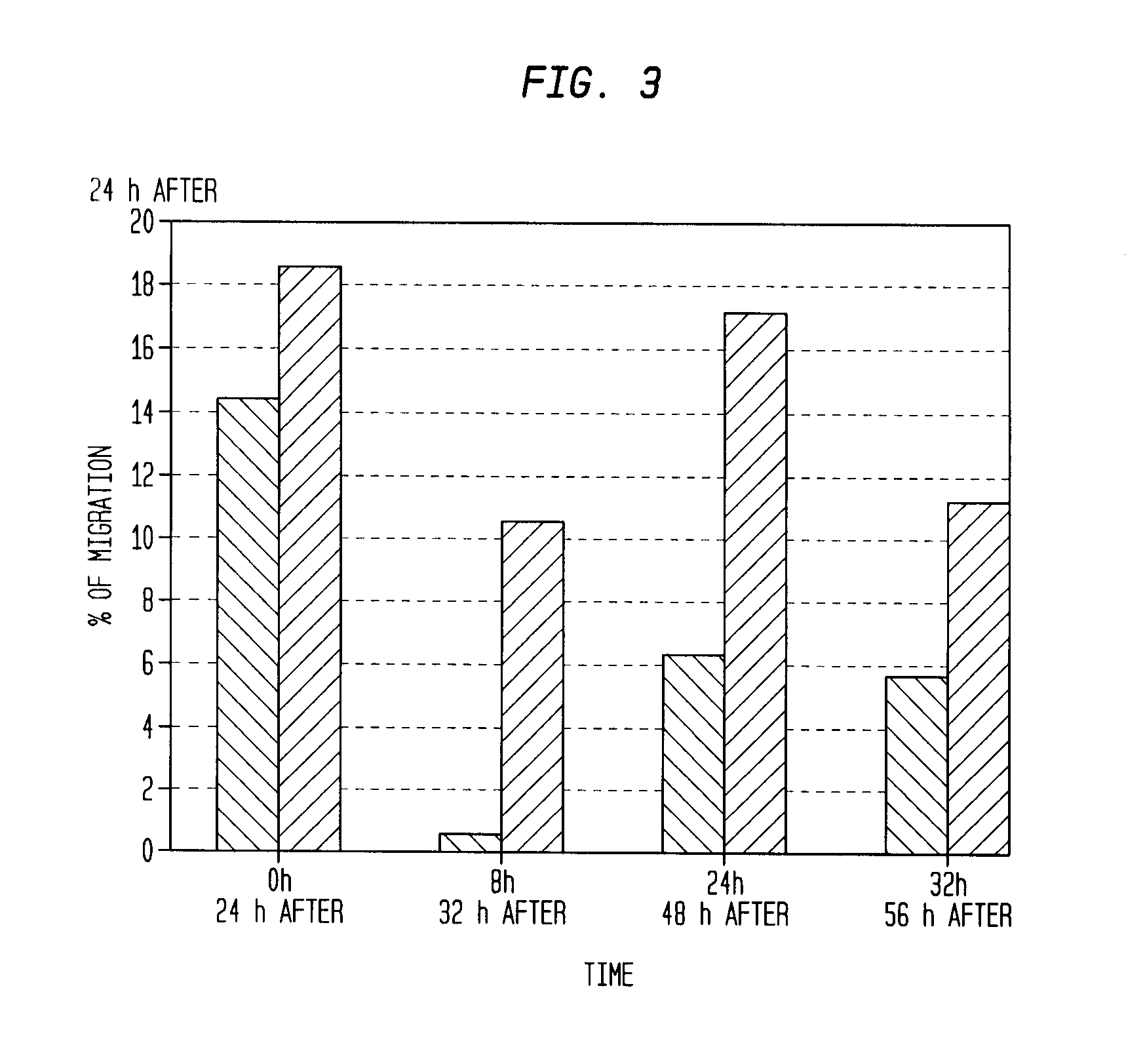[0045]According to another aspect, the described invention provides a pharmaceutical composition for treating an infarct area injury of a revascularized subject following an acute myocardial
infarction resulting from a natural
disease process, comprising: (a) an infarct-injury improving amount of a sterile isolated chemotactic hematopoietic
stem cell product, wherein the infarct area-improving amount of the sterile isolated chemotactic hematopoietic
stem cell product comprises an enriched
population of isolated autologous CD34+ cells containing a subpopulation of potent cells expressing CXCR-4 and having CXCR-4-mediated chemotactic activity such that the enriched population of isolated autologous CD34+ hematopoietic stem cells provides at least 0.5×106 potent CD34+ cells expressing CXCR-4 and having CXCR-4 mediated chemotactic activity; (b) a stabilizing amount of serum, wherein the stabilizing amount of serum is greater than 20% (v / v), and (c) a therapeutically effective amount of at least one compatible agent that promotes cardiomyocyte growth, wherein the composition is administered to the subject parenterally through a
catheter; wherein at least 70% of cells in the enriched population of isolated CD34+ cells containing the subpopulation of potent cells that express CXCR-4 and that have CXCR-4-mediated chemotactic activity when passed through the
catheter and when tested
in vitro are CD34+ cells, and wherein the enriched population of isolated CD34+ cells containing a subpopulation of potent cells that express CXCR-4 and that have CXCR-4-mediated chemotactic activity when passed through the catheter and tested
in vitro: (1) retains the CXCR-4-mediated chemotactic activity; (2) is at least about 70% viable; and (3) is able to form hematopoietic colonies
in vitro, for at least about 24 hours following acquisition from the subject of the enriched population of CD34+ cells containing the subpopulation of potent cells that express CXCR-4. According to one embodiment, the infarct area
perfusion-improving amount of the chemotactic hematopoietic
stem cell product comprises an enriched population of at least 10×106 isolated autologous CD34+ hematopoietic stem cells containing a subpopulation of 0.5×106 potent CD34+ cells expressing CXCR-4 and having CXCR-4 mediated chemotactic activity. According to another embodiment, the composition reduces the infarct area injury more than components (i) plus (ii) or component (iii) alone. According to another embodiment, the infarct area injury comprises apoptotic cardiomyocyte loss in the infarct area. According to another embodiment, the infarct area injury comprises adverse ventricular remodeling after an acute myocardial
infarction, when compared to controls. According to another embodiment, the infarct area injury comprises a progressive decline in heart muscle function following the acute myocardial infarction. According to another embodiment, the infarct area injury comprises hypoperfusion of at least one ischemic peri-infarct zone of
myocardial tissue. According to another embodiment, the infarct area injury comprises myocardial
hibernation in the peri-infarct
border zone. According to another embodiment, the enriched population of isolated CD34+ cells containing a subpopulation of potent cells expressing CXCR-4 and having CXCR-4-mediated chemotactic activity is purified from cellular components of a
bone marrow aspirate acquired from the subject. According to another embodiment, the enriched population of isolated CD34+ cells containing a subpopulation of potent cells expressing CXCR-4 and having CXCR-4-mediated chemotactic activity is purified from
peripheral blood. According to another embodiment, the enriched population of CD34+ cells containing a subpopulation of potent cells that express CXCR-4 and that have CXCR-4-mediated chemotactic activity (a) is capable of forming hematopoietic colonies in vitro; and (b) retains at least 2% of the CXCR-4-mediated chemotactic activity, for at least about 48 hours following acquisition from the subject of the enriched population of CD34+ cells containing the subpopulation of potent cells that express CXCR-4 in (a). According to another embodiment, the enriched population of CD34+ cells containing a subpopulation of potent cells that express CXCR-4 and that have CXCR-4-mediated chemotactic activity (a) is capable of forming hematopoietic colonies in vitro; and (b) retains at least 2% of the CXCR-4-mediated chemotactic activity, for at least about 72 hours following acquisition from the subject of the enriched population of CD34+ cells containing the subpopulation of potent cells that express CXCR-4 in (a). According to another embodiment, the enriched population of CD34+ cells containing a subpopulation of potent cells that express CXCR-4 and that have CXCR-4-mediated chemotactic activity retains at least 2% of the CXCR-4-mediated chemotactic activity for at least about 24 hours following acquisition from the subject of the enriched population of CD34+ cells containing the subpopulation of potent cells that express CXCR-4 in (a). According to another embodiment, the composition is administered through the catheter intravascularly to an infarct-related artery. According to another embodiment, the composition is administered through the catheter into myocardium. According to another embodiment, the composition improves microvascular blood flow in the infarct area, when compared to controls. According to another embodiment, the composition increases perfusion of at least one ischemic peri-infarct zone of
myocardial tissue, when compared to controls. According to another embodiment, the composition increases perfusion to hibernating myocardium in at least one peri-infarct zone of
myocardial tissue, when compared to controls. According to another embodiment, the composition decreases area of infarct area injury, when compared to controls. According to another embodiment, the composition decreases infarct
mass, when compared to controls. According to another embodiment, the at least one compatible agent that promotes cardiomyocyte growth is selected from the group consisting of an
angiotensin converting enzyme inhibitor, a beta-blocker, a
diuretic, an anti-arrhythmic agent, an anti-anginal agent, a
tyrosine kinase receptor agonist, a
vasoactive agent, an
anticoagulant agent, a
fibrinolytic agent, and a hypercholesterolemic agent. According to another embodiment, the at least one compatible agent that promotes cardiomyocyte growth comprises the
tyrosine kinase receptor agonist neuregulin 1. According to another embodiment, the at least one compatible agent that promotes cardiomyocyte growth comprises an
vascular endothelial growth factor selected from the group consisting of VEGF-A. VEGF-B, VEGF-C, and VEGF-D. According to another embodiment, the at least one compatible agent that promotes cardiomyocyte growth comprises
placental growth factor. According to another embodiment, the at least one compatible agent that promotes cardiomyoctyte growth comprises a
catecholamine. According to another embodiment, the
catecholamine is norepinephrine. According to another embodiment, the at least one compatible agent that promotes cardiomyocyte growth comprises endothelin-1. According to another embodiment, the at least one compatible agent that promotes cardiomyocyte growth comprises a
prostaglandin F2α. According to another embodiment, the at least one compatible agent that promotes cardiomyocyte growth comprises
angiotensin II According to another embodiment, the at least one compatible agent that promotes cardiomyocyte growth comprises a
phorbol ester. According to another embodiment, the at least one compatible agent that promotes cardiomyocyte growth comprises
neuropeptide Y. According to another embodiment, the at least one compatible agent that promotes cardiomyocyte growth comprises active
transforming growth factor β1. According to another embodiment, the at least one compatible agent that promotes cardiomyocyte growth comprises Gq
protein. According to another embodiment, the at least one compatible agent that promotes cardiomyocyte growth comprises diacyl glyercol (DAG). According to another embodiment, the at least one compatible agent that promotes cardiomyocyte growth comprises salusin-α. According to another embodiment, the at least one compatible agent that promotes cardiomyocyte growth comprises salusin-β. According to another embodiment, the at least one compatible agent that promotes cardiomyocyte growth comprises
insulin-like
growth factor-1. According to another embodiment, the at least one compatible agent that promotes cardiomyocyte growth comprises
myostatin. According to another embodiment, the at least one compatible agent that promotes cardiomyocyte growth comprises
granulocyte colony-stimulating factor. According to another embodiment, the at least one compatible agent that promotes cardiomyocyte growth comprises macrophage colony-stimulating factor. According to another embodiment, the at least one compatible agent that promotes cardiomyocyte growth comprises
tumor necrosis factor-like weak
inducer of
apoptosis (TWEAK). According to another embodiment, the at least one compatible agent that promotes cardiomyocyte growth comprises a
thiazolidinedione. According to another embodiment, the
thiazolidinedione is
rosiglitazone.
 Login to View More
Login to View More 


